Need some ideas for gifts to give the kids in your life? Check out our toy recommendations for your gift-giving needs this holiday season! Below are a few recommendations for toys we love for various ages. For a fuller guide to toys we love, check out the Toys category of our blogs!
Infant to Toddlers
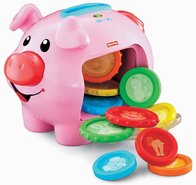
Piggy Bank: This toy has cause and effect concepts, is good to work on making requests (for more coins or certain coins, to open/close the door, music on/off, etc.), building basic concept knowledge (animals, animal sounds, open/close, in/out, on/off, more/all done, etc) and following basic directions. This is a simple, fun toy that also has great potential to help encourage your child’s language development.
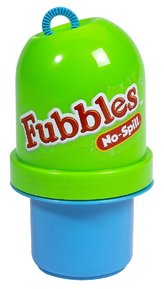
Bubbles: We love the brand Fubbles, as they have the No-Spill containers (amazing!). We have yet to run across a child who does not become fascinated, engaged or super silly when playing with bubbles. When playing with bubbles with your young child you can work on making requests (for more bubbles, for turns, holding the container, using the wand, etc) and functional vocabulary during bubble play (e.g., more, bubble(s), pop, my turn, up, down, in, out, dip, all done). An additional bonus is when your child works on blowing bubbles they are working on their oral motor skills– check out our blog post here to see why this is so important!
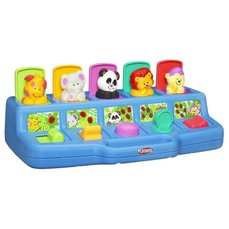
Animal Pop-Up Toy (The Speech Space likes this option or this option). Pop up toys can be used to help work on cause-effect and once your child is a toddler, this toy can also be used for working on problem solving skills (i.e., figuring out how to open each box/make the animals pop up, how to close the boxes/animals). To work on your child’s receptive language skills, you can give your child directions for which animal to pop-up (e.g., “Open the elephant”; “Where is monkey?”). To work on your child’s expressive language skills, you can work on naming the animals and making the animal noises.
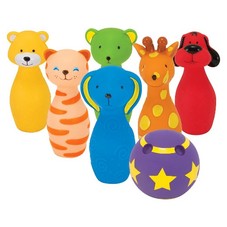
Bowling: Toy bowling sets can be inexpensive and fun for the younger crowd. We like to use them with our early talkers as a way to really encourage using language during play. While setting up the pins you can use functional words (e.g., “Up-up-up” for each pin), name the pins (e.g., animals), or even name the colors or count the pins as your child gets older. Have your child tell WHO and WHAT they should do (“I roll the ball” or “You roll the ball”, etc.), or HOW you should roll it (“Through my legs” or “Under the table”, etc). After they’ve rolled the ball, talk about what happened to the pins, using quantitative concepts like “all” or “one” (e.g., “One fell down!” or “They all fell down!”).
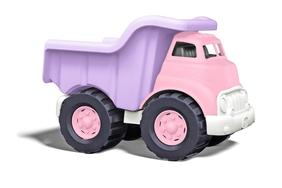
Green Toys Trucks: We love Green Toys vehicles! They are made of recyclable material and are very sturdy. These vehicles are great for young kiddos that are about to be or already on the move. If you get the dump truck or recycling truck you and your child could play putting things in the trucks and then dumping them out (over and over again). You can even work on following directions and vocabulary by telling your child which items to put in the trucks. If they are older, your child could tell you what to help put in the trucks
Preschool to Pre-K
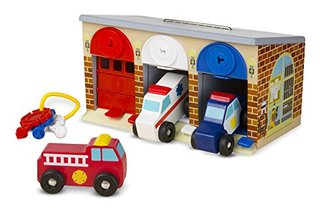
Melissa & Doug Lock and Roll Rescue Garage: This toy can help target a lot of vocabulary. This garage has 3 colored doors and 3 keys. Each door is a different color and each lock is a different shape, so your child needs to match the key to the door color. Once the door is unlocked, you can roll up the garage door and 1 of 3 emergency vehicles is inside (firetruck, police car, ambulance). This toy allows you to target color, shape, preposition (in, out, up, down), and vehicle vocabulary.

Critter Clinic: When we use this toy in therapy sessions we like to put a bunch of small stuffed animals inside each “room” (we found a bunch of old Beanie Babies on eBay for under $8). Have your child tell you which color door they will open and then give your child clues as to what the animal inside will be. You and your child can work on early inferencing and understanding complex language with this toy. Once your child opens the door and finds the animal, have them tell you about it (where the animal lives, defining features, color, parts of the animal, etc) to increase their expressive vocabulary. Once all the animals are out, use the doctor tools to have your child pretend to be a veterinarian. During this time you can help your child with understanding the specific names for each tool and it’s function. If you have extra band-aids (or even some tape and a tissue), have your child tell you where the animals have boo-boo’s and give them bandages.
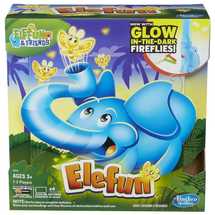
Elefun: We honestly cannot say enough about how much young children love this game. It’s been around forever and if you take care of it, this toy can last a long time (we have one that’s over 10 years old!). We like to start out talking about the parts of this toy (the nets, the elephant, his trunk, the butterflies). If you have multiple children with you, have them ask each other what color net they would like to use, which will encourage social language. Encourage your child to tell you WHERE to put the elephant, HOW to turn it on, WHAT will happen when it’s turned on etc.
**Pro-tip: In order to keep Elefun in tip-top shape, we lay out 2 ‘rules’ when we play: 1.) no punching your hand through the net and 2.) adults are the only ones to touch the trunk.
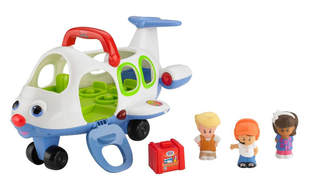
Little People: The Fisher Price Little People were toys we played with growing up and they are still around with more choices than ever! When playing with these toys you can work on targeting pronouns (e.g., he/she, his/her), descriptions (e.g., “The girl who is holding a bird.”), prepositions (e.g., “Put the boy under the table.”), and actions (e.g., “He’s swinging and she will slide.”). Imaginative play is so very important for your child’s language development! Imaginative play with fun toys can help expand your child’s language in a structured environment while you help scaffold and expand their utterances.
Early Elementary
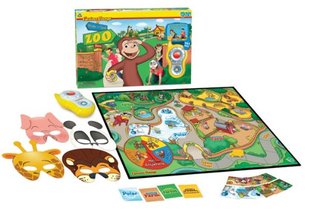
Curious George Hide and Seek Zoo: There is a lot happening in this game, which is why we think kids like it so much. The man in the yellow hat is flying around the zoo and he finds that a bunch of things are wrong! He uses his walkie talkie to tell George (and your child) where there is a problem. This game is great for working on problem-solving skills (e.g., “What’s happening in this picture?”, “Why is this a problem?”, “How can they fix it?”). Your child will love using the walkie talkie and there is a fun part of the game where the animals escape and your child can put on a mask and hide!
**Pro-tip: this game is available on Amazon, but may be less expensive on ebay
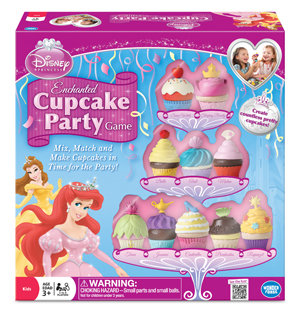
Disney Princess Cupcake: We always modify games when needed, and this one is no exception. There are two main ways we like to play this game to maximize working on language skills. The first way to play with your child would be to separate all cupcake pieces and then tell your child the “recipe” (from the recipe cards) or have your child give you the recipe to create your cupcakes. The second way you can play is by tossing the recipe cards and letting your child get creative by telling you how they want to make the cupcakes. This game is great for increased descriptive language (e.g., “I want the blue wrapper, tall chocolate cake, the yellow and white frosting and the pink flower topper.”) and following directions.
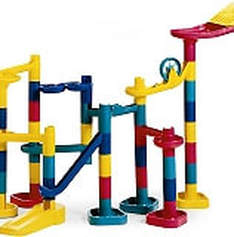
Marble Tower:
This toy allows children to build their own tower or track for marbles to race down. When building these tracks, you are able to work on both receptive and expressive language skills. Receptively, you can describe the piece you want your child to find, or tell them where to put it (e.g., “Put the green piece on top of the blue piece with the wheel.”). Expressively, have your child tell you which piece to find or where to put it. Make sure they are specific and name features of the piece they want (e.g., “It’s pink and has a spinner.”, “It’s the long yellow piece.”).
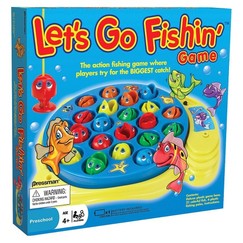
Let’s Go Fishing: Fishing games can be a little tricky (because of the motor skills needed), so we usually recommend this type of game for children that are 5 years or older. If your younger child can successful catch fish, then more power to them and fish away! Once you catch all the fish you can work on sorting or counting. If you want to drag the game out, before putting the fish in their spots, first hide the fish around the room and give your child directions to find them (e.g., “find the blue fish that is under the chair). Or you can hide the fish and ask your child where they found the fish (e.g., in front of the door). These are just a few ways we use this game to work on language skills, but there are many other ways to help build your child’s language skills with this game!
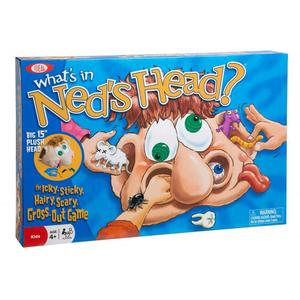
What’s in Ned’s Head: Ned has some really weird (and really gross!) things in his head that you need to get out. Along with all the items in Ned’s head, there are matching picture cards which you can use to describe the objects your child needs to get out. Or you and your child can take turns describing which items you have to get out of his head. When making descriptions make sure to use attributes (i.e., color, shape, size, number), category (i.e., what group does the item belong to), function (i.e., what does the item do or what do we do with the item) and location (where would you find or see the item); these concepts help build your child’s vocabulary and language organization skills. All of our kids think this game is hilarious (especially when we feign not wanting to pull out the things they describe because they are “so gross!” or “so scary!”). You can even talk about the items and compare/contrast them (e.g., which one is your favorite, which one is the weirdest or grossest, why? etc)– just make it fun and silly and your child will enjoy it!
There are so many great toys out there these days. Check back on our blog to see which toys are best for helping your child’s communication development!
If you have questions or concerns about your child’s s development, contact us at The Speech Space. We offer free screenings, which take approximately 30 minutes, and can help identify potential problems.
